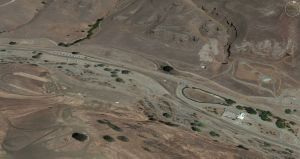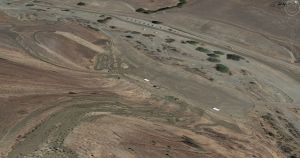What a weekend
This weekend Skips was holding the third and final Hill Climb event at the Carnegie Special Vehicle Recreation Park. SVRPs in CA are state parks which are set aside for using Special Vehicles, such as dirt bikes, quads, Adventure Bikes, etc. The Carnegie park seems to be well suited for motocross and hill climbs, although it seems to me that this park is also well suited for Adventure bikes as well.
Once again, as I prepare to go to Patagonia and produce a blog, video, and audio segments, I use every possibility to see if I can improve my video editing skills. I was fortunate enough to have Jenifer Steinman come over and give me some coaching, so if you see anything here that’s good, it’s due to her help, and if you see anything bad, then you should assume that it’s my fault.
At any rate, here’s the video…
We arrived at about 8:00 AM, and while the racing would not start for another 90 minutes, the paddock was wide awake and it seemed that everybody was preparing their bikes for their attempt at the hill. We parked next to a family that let us shelter our bikes under one of the only trees in the park, and I had a chance to talk to a little 7 year old hill climber. He was confident, enthusiastic, and just about as focused as any 7 year old boy that you might ever meet. He described his attempts up the hill the day before and told me that he had taken 14.7 seconds to go up the route that they setup for the young riders. He also said that the “more difficult hill” took him over 18 seconds.
As you’ll see from some of the video excerpts later on in this post, an 18 second attempt at the hill is an epic result, and I had nothing but respect for this young and highly skilled little hill climber.
Multiple classes attack the hill
What I learned about hill climbing is that there are numerous classes which are generally separated by three things. First, they are separated by whether the rear swing arm has been extended or not. Second, by the size of the engine, third, in a class simply called open, they are allowed larger displacement engines, any form of tire (including chains, scoops, paddles, etc) and any type of fuel (including Nitrous, and any high-octane fuel).
In-between each class, the hill is often reconfigured so that the next class has a slightly different route to the top, with the bigger classes getting served up a more and more complicated configuration of the hill. This approach allows for the new class to climb a portion of the hill that has not been severely rutted and deteriorated from the abuse that these hill-climbing monsters can dish out.
Spectating at a hill-climb event
After a quick tour of the pits from the vantage point of the bike, we sat down on the bleachers and enjoyed watching the bikes climb the hill. The event started with bikes that were effectively stock, and it progressed to those same bikes with extensions, until we got to the open class, where they were often running 750cc – 1000cc 4 cylinder engines on purpose-built frames, with extended rear swing arms, and often paddles and chains on the rear tire, to aid with traction.
As we watched the bikes and riders make their attempts at the hill, a few things became quite clear. First of all, to a large degree, if you only look at the superficial aspects of the bikes, the bikes look quite similar, especially all of them that have the extended rear swing arms. But,if you look just beyond the superficial aspects of the bike, you’ll start to see and hear the differences.
Some of the bikes depend on 2 stroke motors while some depend on 4 stroke motors. If you talk to others that attend these events, you’ll quickly hear that these other enthusiasts and riders often align themselves around their love for either 2 stroke or 4 stroke engines. While these engines make quite different sounds, I was really taken in by the roar of all of the bikes as they were steered up the hill. These things are awesome little powerhouses, designed to run at high RPM, for no more than 30 seconds at a time but during that 30 second period, they are nothing short of awesome.
The Hill
As you can see from the pictures below, the hill has numerous tracks up running up it. These tracks have been created over years of running hill climbs on this hill, but from what I saw this morning, it’s hard to imagine that this hill could have survived more than a couple of weeks of hill-climbs.
 At one point, we were standing directly behind the bikes as they exit the start, and head up the hill. We were standing there during the open class racing, and I was really surprised with the amount of dirt that these bikes kick up. The first couple of bikes were running paddle tires, so when they exploded out of the gate, they hurled buckets of dirt backwards, directly towards where I was standing. I did not get hurt in any way, but there sure was a lot of dirt.
At one point, we were standing directly behind the bikes as they exit the start, and head up the hill. We were standing there during the open class racing, and I was really surprised with the amount of dirt that these bikes kick up. The first couple of bikes were running paddle tires, so when they exploded out of the gate, they hurled buckets of dirt backwards, directly towards where I was standing. I did not get hurt in any way, but there sure was a lot of dirt.
 These pictures don’t really do justice to the hill, but trust me, the hill is very steep, and covered with all manner of obstacle. in this picture, you get a better feel for how the hill rises, and at the crest, there is a road that the bikes use to travel around the ridge, and ultimately make their way down to the main area once they have completed a successful run, all the while generally staying out of the way of all of the other bikes that are attempting the hill.
These pictures don’t really do justice to the hill, but trust me, the hill is very steep, and covered with all manner of obstacle. in this picture, you get a better feel for how the hill rises, and at the crest, there is a road that the bikes use to travel around the ridge, and ultimately make their way down to the main area once they have completed a successful run, all the while generally staying out of the way of all of the other bikes that are attempting the hill.